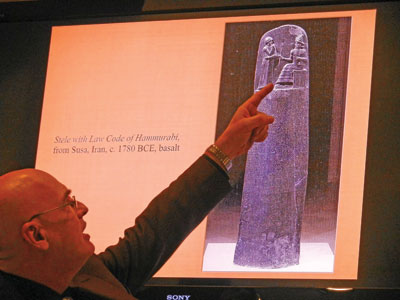
Over the past eight weeks Preston Metcalf of the Triton Museum of Art has been discussing the meaning behind artistic symbols – from symbols of the feminine to symbols of politics and power. And yet, each week the same message is stated – that art, regardless of the subject matter, is about the viewer as much as it is about the symbols and the artist. And, on March 1, during the last lecture on “Symbols into the 20th and 21st Centuries,” Metcalf again stressed the importance of that statement.
Lecture attendees were shown paintings by Max Ernst, Pablo Picasso Frida Kahlo, Salvador Dali and other well-known artists from the last two centuries. Each painting, regardless of subject matter, was somehow about the viewer.
“Now what have I told you for so many weeks,” said Metcalf. “When we look at these symbols and we learn to start reading them and deciphering them. We’re not talking about somebody out there. Ultimately, we are not talking about Frida Kahlo. We are not talking about Salvador Dali. We are not talking about the Christ or the Buddha or any of them because all of these symbols represent you. That’s what it always comes down to. That is the most elemental interpretation of a symbol. Goethe wrote all things are metaphors. If all things are metaphors then we are the subject of those metaphors. In other words, that is Frida Kahlo, but it’s also you and me. That’s how we interpret these symbols.”
Metcalf used this lecture to reiterate many of the points he stressed in previous lectures. He reminded those in attendance that art should meet one of four functions: the metaphysical (waking the viewer up to the awe), the cosmological (explaining how the world works), the sociological (how to function within society), or the pedagogical (teaching the viewer how to go through life). “If you are not getting at least one of these four functions in a work of art either you’re not looking at it closely enough or it doesn’t have it. And if it doesn’t have it, it’s not a great work of art,” said Metcalf.
Of course, meeting one of the four functions doesn’t necessarily qualify a piece of art as great. In order to be considered great, according to Metcalf, the piece of art, whether it be a painting, literature, performance or music, must meet at least some of the following criteria: it must have aesthetic splendor; cognitive power; strangeness and originality; conflict, ambivalence and irony; achieved anxieties or fear of mortality; a metaphor, desire to be elsewhere; be larger than any social program; self change and subject inwardness; creatively misread its precursors; and demand re-experiencing.
“We have all the symbols, they’re there. They’re waiting for us to read them, but do we take the time?” said Metcalf. “That’s what I hope you get out of this series. Stop and take the time. If you don’t know, find something you do know, chances are you’ll be on the right track because we already shared these symbols. We understand what they mean.”
Even though this lecture series is over, Metcalf will return to teaching art history with a five-part mini series in April. The series beings with “The Amazing Adventures of La Gioconda” on April 19 and will continue the third Thursday of every month through August 16. Additional information can be found at www.tritonmuseum.org.





